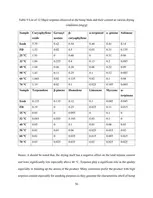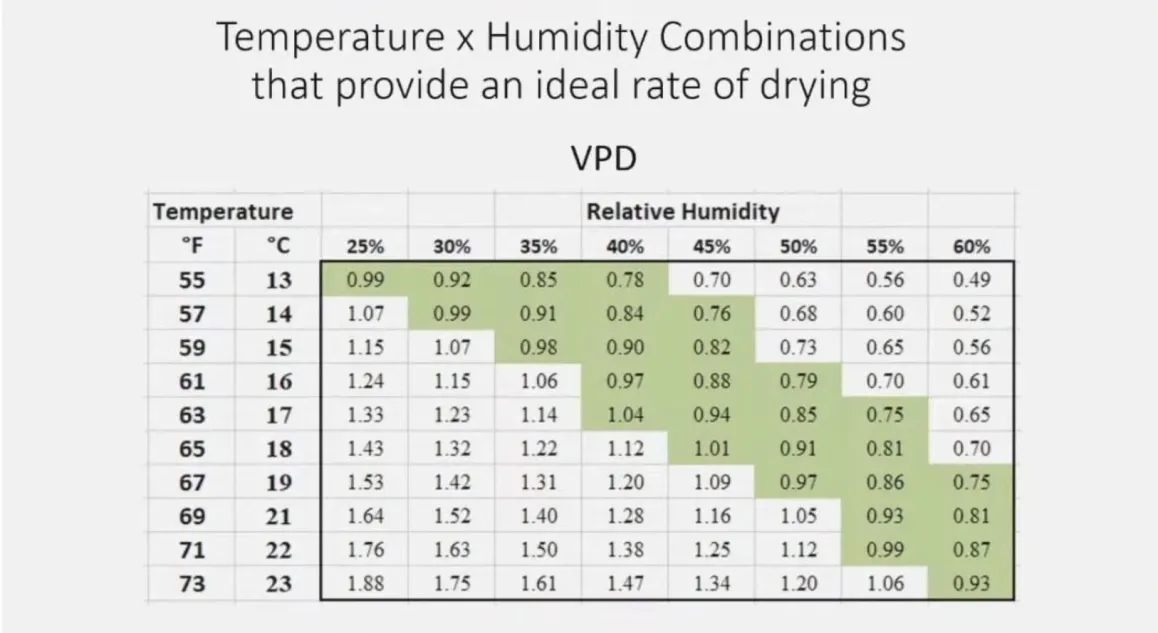So,
da ich sowas hier noch nich gesehen hab, hier mal bisschen Lesestoff für euch.
Trockne so seit geraumer Zeit und ist auch ähnlich zu der Uralt Gläser Methode wo man auch immer schnell ins Glas wollte zum curen.
Kann bestätigen, dass schnellere Trocknung + Einhaltung der Parameter + Drucksteigerung wie beschrieben zu genau dem gewünschtem Ergebniss führen --> schmackhafteres Weed. Gut Rauch ![]()
Quelle: https://sharkmousefarms.com/blogs/news/the…tion-techniques
The Science Behind Optimal Post-Harvest Practices revealed: Unveiling the Truth About Drying and Preservation Techniques
The Science Behind Optimal Cannabis Cultivation revealed: Unveiling the Truth About Drying and Preservation Techniques
In a groundbreaking exposé, The Deep End brings to light the hidden secrets of cannabis cultivation that could revolutionize the industry. Through meticulous research and analysis, Sharkmouse Farms uncovers the flaws in conventional wisdom and presents a cutting-edge approach to maximizing the quality of cannabis flower
The Post-Harvest Conundrum: Decades of Trial and Error Unraveled
The area for the largest potential Improvement in your cultivation remains The post-harvest process, The practices we as growers have adopted, evolve from decades of trial and error experience that aimed to achieve 2 main goals. Secondary metabolite and volatile compound preservation, and safe storage conditions.Nearly all of the steps in the workflow we’ve employed to get there are based off anecdotal logic. Regardless of how flawed that logic has come to be.
Drying your fresh flower in conditions in the 60f/60% rh range, known as the “low and Slow” method contends that if we dry our flower at the lowest possible temperature,and lowest vapor pressure possible, that we can slow the rate of evaporation in that flower, preventing them from reaching their dry target before compounds like chlorophyll and sugars have a chance to degrade, while mitigating excessive evaporative forces that can pull out those secondary metabolites and volatile compounds. In our heads, the idea that cooler temperatures will prevent the oxidization of those precious compounds. And knowing that a safe water activity (aW0 of 0.64 is necessary for not only safe storage, and the prevention of mold and yeast, but also to ensure ideal consumption conditions as to prevent overly moist, or over-dried flower. These ideas, align with the notion that “Low and slow” is the ideal way to achieve those conditions. If we add to the fact, that out of context, the formula Water activity is equal to equilibrium relative humidity divided by 100: (a w = ERH/100) where ERH is the equilibrium relative humidity (%) ie. 0.64= 64%/100, it all seems to indicate that 60/60 is the right move!!!
The problem is, thats not how thermodynamics work!
According to Fick's first law: Movement of particles from high to low concentration (diffusive flux) is directly proportional to the particle's concentration gradient. What does that mean for us?
The evaporative forces of the surrounding environment are directly proportional to the density of the material it has to be pulled from. Diffusion works a lot like osmosis. Areas of high moisture will move to areas of low moisture until it equalises. If youve ever run the “Low and slow” method, you’ll recognize the “dry” flower feel after only 2 days. Then several days later, its back to moist again. As the moisture on the surface of the flower evaporates into the ambient atmosphere, the principal of water adhesion is still applied. Surface water getting pulled out of the flower, draws moisture from deeper within the flower toward the surface. But those same evaporative forces, based on ficks’s law, overwhelm those adhesion forces the deeper into the flower material we get, at at some point, that chain breaks, and that internal moisture is now being pulled out with significantly less force than it was at full moisture content %. While the concentration gradient has increased, so has the membrane thickness ( the amount of layers of flower the moisture has to diffuse through until it gets to the surface.
This specific condition creates 2 problems.
The biggest being that internal moisture content itself: when that water adhesion chain breaks, the moisture content within that flower is still in the 30% range; far above the % necessary for botrytis to proliferate. with a relatively high moisture content of 30% inside the te flower, mold growth could potentially occur within a matter of days to a few weeks. The combination of moderate temperature, moderate humidity, and high moisture content creates conditions that are favourable for mold proliferation.
Mold spores ARE present in the environment and can settle on the flower surfaces. Given the high moisture content inside the flower, mold spores may germinate and begin to grow more rapidly under these conditions. The 60% relative humidity provides additional moisture to support mold growth, especially if the flower's moisture content is already elevated. Once we break the water adhesion chain, that internal moisture is left to sit for another 10 days, very slowly working toward the surface and the chances of proliferation increase exponentially with time.. After weeks at those conditions, and even if your flower passes CoA, your flower is MOLDY! As of 2023, States like Michigan and Maryland allowed for 100,000 colony forming units per gram of dried flower. In all likelihood, most home cultivators, drying their flower in uncontrolled environments , in these conditions are exceeding those CFU’s 3x to 5x over; not quite visible to the naked eye, but a definitive health concern.
The other issue that comes with “low and slow is the direct contradiction of its intended goal of terpene preservation.REmember how we discussed Fick’s law, and how water at the surface gets pulled out faster than the water in the middle? This leaves our flower in a position where those compounds on the surface and near surface layers are being entirely dehydrated the the interval between the atmospheric pressure breaking water adhesion, and the time it takes diffusion to reach those dehydrated layers. Going well below your intended aW in those layers, volatilizing a lot of those compounds in the process.
What about the cool temperature? Doesn't that mitigate the volatilization? No! The single most predictable constant in this equation is that once we chop the plant down, the PSM numbers are going down, never up! Heat, Light, oxygen and time all have a significant impact on how, which and to what extent these compounds volatilize.
**The behaviour of individual terpenes was
analysed and were grouped based on their evaporation behavior against drying temperature.
Terpenes such as caryophyllene oxide (average content among all the drying conditions is 0.16%
or 1.6 mg/g; standard deviation- 0.01%) , sabinene (0.01%; SD- 0.001%), and α-terpinene
(0.002%; SD- 0.0002%), ocimene (0.001%; SD- 0.0001%), α-humulene (0.001%; SD- 0.0001%)
were decreased with drying but stable with the increase of drying temperature. Terpenes such as,
myrcene (0.006%; SD- 0.0005%), terpinolene (0.006%; SD- 0.0002%), α-pinene (0.02%; SD-
0.002%) and β-caryophillene (0.03%; SD- 0.001%) decreased gradually with the increase of
temperature. Terpenes such as, Guaiol, Nerlidol, g-terpinene, geranyl acetate, p-cymene, linalool
were almost completely evaporated with drying, leading to a significant decrease. All the
remaining terpenes that were analysed were not observed in fresh hemp samples itself.**
What is so telling about the above table is not the obvious fact that air temperature effects terpene loss, but the rate at which it does, at various temperatures. If we use the Caryophyllene as an example. The sample dried at 25 degrees celsius vs the sample dried at 32 degrees saw a Caryophyllene total difference from 1.91% to 1.86 % a 2.6 % overall reduction. If we extrapolate the findings from Ross and ElSohly , who ***measured a 31.0, 44.8, and 55.2% loss of terpene content in Cannabis sativa inflorescence which had been air dried and stored for 1 week, 1 month, and 3 months, respectively, as compared to freshly harvested inflorescence (Ross and ElSohly 1996).**
While further work from -The preservation and augmentation of volatile terpenes in cannabis inflorescence 2020 showed **A more comprehensive analysis of 37 major terpenoids (of the 93 terpenoids analyzed) revealed the same general trend as α-pinene and β-caryophyllene; in other words, decreasing concentrations over time for all storage conditions (Figure 6)***[ https://www.frontiersin.org/journals/plant….583605/full#F9]Justin Bueno, Emily Leuer, Michael Kearney Jr, Edward H. Green & Eric A. Greenbaum; it becomes painfully clear. While temperature does in fact degrade volatile compound %, it’s effect are dramatically outpaced by the effects of time on degradation, regardless of storage conditions.
All of this means, that the longer we have plants up on the rack, the lower those numbers are going to go. The rate of degradation at 22c vs the rate of degradation at 25c or 32 c are in the 1-2% decrease range compared to the rate of degradation over time, regardless of storage conditions in the 30% range over week long durations.
How does any of this matter? We need two weeks to weeks to degrade chlorophyll for a smooth taste
This anecdotal ideology stems from the fact that quickly dried flower often has a grassy, or hay- like taste, which is associated with chlorophyll . this can be partly true. While a majority of the harshness and and overpowering grass tast can be attributed to either a hot burning temperature of the low moisture content flower,combusting excess carbon or the high combustion temperature of overly moist flower creating steam as it evaporates the excess moisture to reach its ignition point.
Darkness plays a major role in the ability to dry over short durations as shown by Effects of Light on Degradation of Chlorophyll and Proteins during Senescence of Detached Rice Leaves Katsuhiko Okada, Yasunori Inoue, Kazuhiko Satoh, Sakae Katoh 1992 *** When leaves had been left in total darkness for three days at 30°C, there was an initial long lag that lasted for one whole day and then chlorophyll was rapidly degraded in the second and third days. Breakdown of chlorophyll was strongly retarded by continuous illumination with white light of intensity as low as 0.5 μmol photons m−2 s−1***Thylakoid membrane proteins and soluble proteins were also largely degraded during three days in the dark.** Showing us that the degradation of a majority of the chlorophyll present in the detached appendage was degraded in the first three days in the absence of par light as little as 4 umol.
How can we apply this knowledge in achieving a better dry?
Using the available desoption Isotherm formulas in DRYING KINETICS AND THE EFFECTS OF DRYING
METHODS ON QUALITY (CBD, TERPENES AND COLOR) OF HEMP (Cannabis sativa L.) BUDS Sai Kiran Reddy Challa. We can see that when using conventional drying methods 2020, we can formulate a STEP DOWN drying program that achieves all the limiting factors addressed aove.
We need to dry as cool as possible, as fast as possible, but while maintaining enough atmospheric pressure to get both phases of moisture in your flower out at a constant rate that accounts for the variable gradients in the different drying phases ( remember Fick’s Law?) while also ensuring we allow for enough time for the degradation of those unwanted compounds
If we increase the vapor pressure in our dry space, we increase the evaporation rate. That means that the surface, and near-surface layers will evaporate at a quicker rate, diffusing more moisture behind it before that adhesion chain breaks. If at this point, we maintain that same vapor pressure, we slow the evaporation rate considerably, lengthening the amount of time we spend trying to get to our safe aW.
By slightly adjusting the VPD higher, to transition to our second phase of drying, will help pull that inner moisture closer toward the surface where we want to once again increase the pressure to equalise the evaporation rate. By implementing this method, we reduce the the oxidative stress of a dehydrated surface layer for extended periods, while maintaining a consistent diffusion rate through the whole process.
Harvesting our plants during the final hour of their dark cycle allows for maximum respiration of the final light cycles metabolic energy, while begging that chlorophyll degradation process. Bucking the plant down from its main stalk, separating off branches into individual sections will allow for a more even diffusion without the additional gradient pressure of the moisture contained within the main stalk. Hanging these individual sections spaced evenly enough apart to avoid unnecessary overlay but close enough in proximity to maintain a single homogenous micro-climate.
We want to begin our dry phase in a precise climate of 72 degrees fahrenheit, or 22.2 degrees celsius at 55% relative humidity and a 1.2 kPa, over the course of 48 hours. This is considered our phase 1 of drying and will begin that process of evaporating that surface moisture, while pulling the inner moisture of your flower toward the surface through adhesion. After the initial 48 hours, we will increase our pressure slightly, as a transition to phase 2. By increasing the tef, or mp and kPa to 74f, or 23.3c, and 1.39 kPA respectively, while reducing our rh% to 52%, we increase the rate of transpiration, while not overwhelming adhesion, leaving that chain intact as that moisture is pulled closer to the surface. After a 24 hour adjustment period. We move into the final phase of our dry, which is phase 2. Increasing temperature and VPD to 75 degrees fahrenheit or 23.9 degrees celsius, and 1.5 kPa for the final 48 hours will reduce the remaining moisture content in the near-surface layers down to a final dry moisture content of 10%.
We are now off the rack, ready to buck and trim in 5 days, limiting degradation to the highest possible degree to the overall flavour profile of your harvest.
Remember when we discussed aW=ERH%/100? The whole purpose of drying isnt to reach equilibrium. In this context, the formula is only useful in describing the thermodynamic properties of water movement across a membrane according to the gradient pressure applied to it. Were trying to move water out to a specified set as quickly as possible, not equlaize it
While all of what youve just read may initially seem counterintuitive to the logic youve applied to drying and the experience youve had in employing it towards drying, If we view it in the lens of maintaining and preserving those compounds we covet most in our dried flower, it begins to make sense that the sooner we can get the plants out of that awkward phase where its no longer living and not safe to store;by existing in conditions that are not conducive to that end, the quicker we can get into conditions that are.
But we’re not quite there yet. Youve successfully completed the most effective conventional dry method according to the science, but we still need to complete another equally important step. Curing. Bringing your dried flower to life.in the next issue of: The DEEP END
Embrace the future of cannabis cultivation with a precision-driven methodology that redefines industry standards. Stay ahead of the curve and unlock the full potential of your harvest by implementing cutting-edge techniques that prioritize quality, efficiency, and innovation.
Join us on the forefront of cannabis cultivation excellence, where science meets sustainability and tradition yields to transformation. Experience the transformative power of knowledge and precision in shaping the future of cannabis cultivation practices.
Now That’s Dope Science
Like what you read? Make sure to subscribe to our email list to be the first to read new articles, get first access to new drops and special offers. Make sure to follow on all our other platforms @sharkmousefarms




